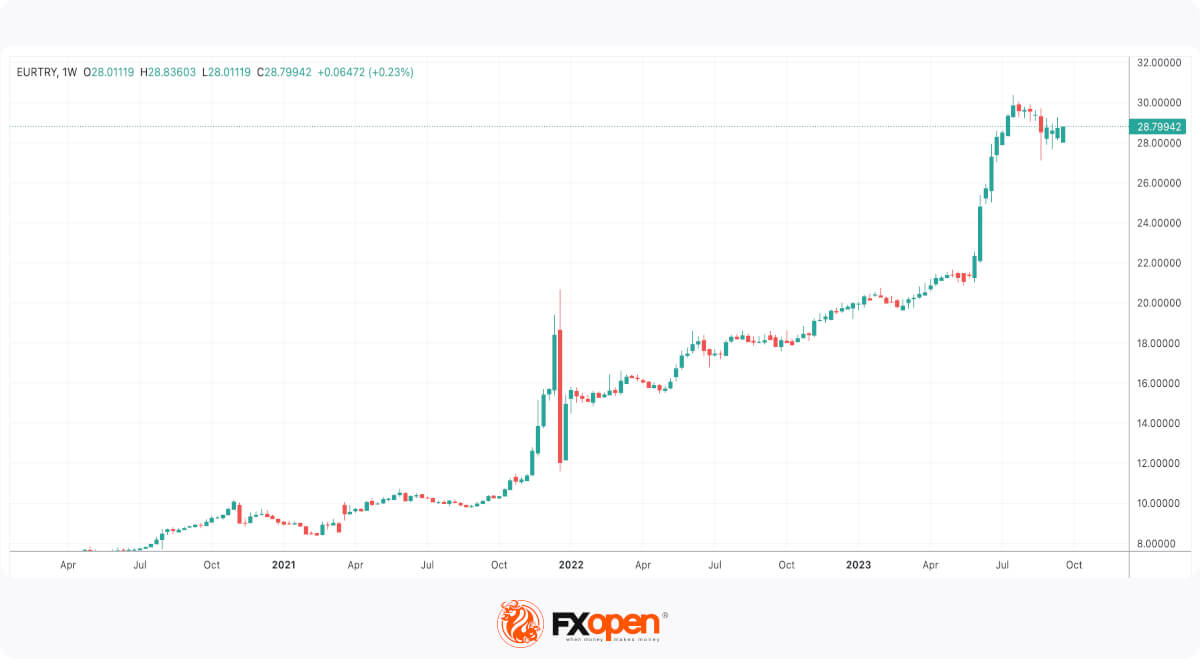EURTRY: A Volatile Landscape Amidst Turkey’s Economic Challenges
As the holiday season fades into memory, Turkey, a perennial favourite among tourists from various corners of the globe, reflects on its unique position in the world of international trade and finance.

For decades, Turkey has welcomed visitors with open arms, offering affordable package tours, all-inclusive hotels, and a vibrant tourist industry that caters to individuals and families seeking weeks of relaxation. However, despite its thriving tourism sector, Turkey has grappled with a currency crisis, particularly in relation to the Euro, for the better part of six years.
Turkey’s Tourism-Driven Economy
Turkey boasts one of the world’s largest and most advanced tourist industries, serving as a gateway for travellers from Europe, the Caucasus, the Middle East, and Eurasia. This robust industry is built around package tours, all-inclusive resorts, and other enticing options designed to provide travellers with an affordable escape. While tourism is a cornerstone of the Turkish economy, its currency, the Turkish Lira, has faced a persistent decline against major currencies, leading to economic uncertainty.
The Turkish Lira in the Spotlight
The Turkish Lira, while not considered a major currency, holds significant interest for traders due to Turkey’s status as a productive nation with strong trade agreements worldwide. The country’s “open-door” policy for tourism further adds to its appeal. Yet, the Turkish Lira’s struggles persist.

Recently, during the summer months, a subtle shift occurred in the EURTRY pair. Over the past year, the Euro had been steadily gaining value against the beleaguered Turkish Lira. However, a pivotal moment arrived when Turkey’s central bank made a bold move by raising interest rates to a staggering 25% on August 24. This decision prompted a shift in the dynamics of the EURTRY pair, with the Turkish Lira showing signs of a resurgence. For the first time in over six years, the Lira began gaining ground against the Euro.
The first half of September was marked with numerous attempts to pull the EUR/TRY pair down. This level of volatility underscores the impact of Turkey’s central bank policies on the currency markets. While these measures have halted the Lira’s freefall to some extent, the overall sentiment remains unfavourable for the currency.
The Ongoing Challenges
Amidst sensational headlines suggesting a ‘Lira surge’ following the rate hike, analysts remain cautious, anticipating further challenges for the Lira. With inflation hovering around 60% and exhibiting volatility, Turkey’s economic landscape remains uncertain. Earlier this year, inflation reached as high as 70%, adding to the economic turbulence.
However, it’s not all doom and gloom. Turkey’s industrial sector is robust, tourists continue to flock in, and investments from countries like Russia, Ukraine, and the Asia Pacific region are flourishing. Many investors see the Lira’s low valuation as an advantage, taking a long-term view when making commercial investments in Turkey.
The path ahead for the EURTRY pair remains unpredictable, with significant volatility driven by an array of factors. Turkey’s economic landscape is marked by an intricate blend of industry, inflation woes, and a currency that has been in dire straits for years. As the world watches, the EURTRY pair stands as a symbol of the uncertainty and opportunities that characterise this dynamic nation’s economic journey.
This article represents the opinion of the Companies operating under the FXOpen brand only. It is not to be construed as an offer, solicitation, or recommendation with respect to products and services provided by the Companies operating under the FXOpen brand, nor is it to be considered financial advice.




